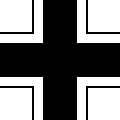| VK 16.02 Leopard | |
|---|---|
 | |
| Type | Light tank |
| Place of origin | Nazi Germany |
| Service history | |
| In service | Never produced |
| Production history | |
| Designer | M.A.N. / MIAG / Daimler-Benz |
| Designed | 1942 |
| Variants | 2 |
| Specifications (as designed) | |
| Mass | 21,900 kilograms (48,300 lb) |
| Length | 4.74 metres (15 ft 7 in) |
| Width | 3.1 metres (10 ft 2 in) |
| Height | 2.6 metres (8 ft 6 in) |
| Crew | 4 |
| Armor | 16–50 mm |
Main armament | 5 cm KwK 39 (planned) |
Secondary armament | 7.92 mm MG 42 machine gun |
| Engine | Maybach HL 157 P 550 horsepower (410 kW) |
| Transmission | Maybach OG 55 11 77 semi-automatic |
| Suspension | Torsion bar |
| Ground clearance | 500mm |
Operational range | 500 kilometres (310 mi) (on roads), 300 kilometres (190 mi) (cross-country) |
| Maximum speed | 45 kilometres per hour (28 mph) on roads, 30 kilometres per hour (19 mph) cross-country |
Steering system | Multi-stage |
The VK 16.02 Leopard was a planned German light reconnaissance vehicle designed from mid-1941 through to January 1943, with serial production scheduled for April 1943. It was intended to be the replacement of Panzer II Ausf. L "Luchs". The project was canceled in January 1943 before the first prototype was completed as it did not meet the requirements for 1944. A wooden mock up of the Waffenträger (English: "weapon carrier") variant was produced.
